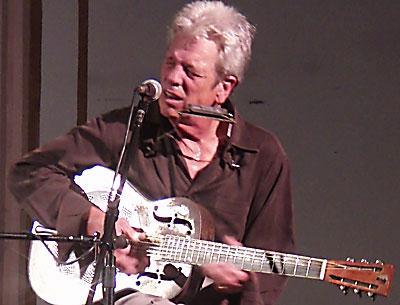Opinion: A Sound to Remember

In his 70th year, the remarkably youthful John Hammond opened the second annual Sag Harbor American Music Festival with a memorable set that spanned a wide breadth of the blues. There could hardly be a more suitable choice than Mr. Hammond, a former East Hampton resident who is also marking his 50th year as a professional musician.
Mixing his own compositions with those he learned in a lifetime of immersion in this distinctly American form, he introduced most songs with a story about its author, sometimes involving his own first encounter with same, usually eliciting laughter from the rapt audience that filled the Old Whalers Church.
Though his father was a legendary producer and talent scout who discovered and/or guided the careers of Billie Holliday, Charlie Christian, Aretha Franklin, Bob Dylan, and Bruce Springsteen, among others, the younger Hammond took no shortcuts to stardom, instead developing an organic, authentic sound and style through his own experience. This, as he recounted, included pumping gas and riding buses to gigs in Los Angeles, and immersing himself in the country blues of the rural South and the gritty electric blues of Chicago, where he and a young musician named Mike Bloomfield would hear, and later perform with, the likes of Muddy Waters, Howlin’ Wolf, and Little Walter.
For nearly two hours, Mr. Hammond performed with an unwavering intensity, lanky body coiled atop a stool, hands in constant motion, left foot resolutely stomping quarter notes, head thrown back or face contorted as he channeled Buddy Guy or Robert Johnson himself. His left hand sped from one end of the guitar’s neck to the other and back again, spitting out licks between each vocal line.
He is similarly virtuosic on the harmonica, an accompaniment to most of the night’s repertoire. A veritable one-man band — frenzied guitar, wailing harmonica, commanding vocal, and that ever-stomping left foot — his multitasking dexterity was a sight to behold.
He performed a broad range of music. His own “Heartache Blues” was followed by “Get Behind the Mule,” from his Tom Waits-produced “Wicked Grin” album, a collection of songs written by Mr. Waits. Next up was “My Time After a While,” a song he had vowed to learn, he recalled, after hearing it on the B-side of a Buddy Guy record. He once introduced it as such, he added, when a man approached him and angrily exclaimed, “Buddy Guy didn’t write that song! I did!” “So I’d like to play a song by Robert Geddins,” Mr. Hammond deadpanned.
He alternated between acoustic guitar and Dobro, a bottleneck slide employed on the latter. His rendition of Muddy Waters’s “Sail On” was all guttural vocals, mournful slide guitar, and a harmonica evoking a far-off train whistle. He followed with his own “You Know That’s Cold,” to which he added the signature licks of “Dust My Broom,” a rock ’n’ roll prototype written by either Robert Johnson or Elmore James.
“Love Changin’ Blues,” said Mr. Hammond, was written by Blind Willie McTell, who first recorded in 1926. This was followed by his own “Come to Find Out,” from his 2005 release “In Your Arms Again.”
Sonny Boy Williamson, Mr. Hammond told the audience, was a bearish, menacing man who sang songs such as “Your Funeral My Trial.” With Mr. Bloomfield, Mr. Hammond saw Mr. Williamson perform in Chicago — not from the stage but from a table, sandwiched between two women and a bottle. He then performed Williamson’s “Fattenin’ Frogs for Snakes,” followed by Waters’s “I Can’t Be Satisfied.”
It was the country singer-songwriter Hoyt Axton, in a chance meeting at a gas station in Los Angeles, who gave Mr. Hammond his first break. Mr. Axton, he recalled, drove up in a white Porsche and instructed him to fill the tank. A Martin D-45 acoustic guitar (“which cost three or four thousand dollars even then”) sat in the passenger seat, and Mr. Hammond was captivated. Mr. Axton invited him to play it, was suitably impressed, and arranged Mr. Hammond’s first professional performance. One led to another, and soon Mr. Hammond was driving a 1955 Ford Crown Victoria back toward Chicago, the car gaining him instant favor with the older blues musicians he and Mr. Bloomfield revered.
These uniquely American experiences saturate Mr. Hammond’s own oeuvre and style. His festival audience was fortunate to witness a performance by a genuine link to our musical and cultural heritage.
As the conclusion drew near, one song needed no introduction. The bottleneck slide moved across the Dobro’s six strings, and Mr. Hammond began to sing. “You better come on, in my kitchen/Well, it’s goin’ to be rainin’ outdoors.”
With eyes closed, one might have thought Robert Johnson himself was in the house.
